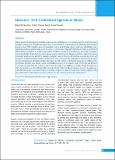Please use this identifier to cite or link to this item:
https://hdl.handle.net/20.500.14356/1607| Title: | Abortion: Still Unfinished Agenda in Nepal |
| Authors: | Shrestha, Dirgha Raj Regmi, Shibesh Chandra Dangal, Ganesh |
| Citation: | ShresthaD. R., RegmiS. C., & DangalG. (2018). Abortion: Still Unfinished Agenda in Nepal. Journal of Nepal Health Research Council, 16(1), 93-98. https://doi.org/10.33314/jnhrc.v16i1.1367 |
| Issue Date: | 2018 |
| Publisher: | Nepal Health Research Council |
| Article Type: | Short Communication |
| Keywords: | NA |
| Series/Report no.: | Jan - Mar 2018;1367 |
| Abstract: | Abstract Unsafe abortion is affecting a lot, in health, socio-economic and health care cost of many countries. Despite invention of simple technology and scientifically approved safe abortion methods, women and girls are still using unsafe abortion practices. Since 2002, Nepal has achieved remarkable progress in developing policies, guidelines, task shifting, training human resources and increasing access to services. However, more than half of abortion in Nepal are performed clandestinely by untrained or unapproved providers or induced by pregnant woman herself. Knowledge on legalization and availability of safe abortion service among women is still very poor. Stigma on abortion still persists among community people, service providers, managers, and policy makers. Access to safe abortion, especially in remote and rural areas, is still far behind as compared to their peers from urban areas. The existing law is not revised in the spirit of current Constitution of Nepal and rights-based approach. The existence of abortion stigma and the shifting of the government structure from unitary system to federalism in absence of a complete clarity on how the safe abortion service gets integrated into the local government structure might create challenge to sustain existing developments. There is, therefore, a need for all stakeholders to make a lot of efforts and allocate adequate resources to sustain current achievements and ensure improvements in creating a supportive social environment for women and girls so that they will be able to make informed decisions and access to safe abortion service in any circumstances. |
| Description: | Short Communication |
| URI: | http://103.69.126.140:8080/handle/20.500.14356/1607 |
| ISSN: | Print ISSN: 1727-5482; Online ISSN: 1999-6217 |
| Appears in Collections: | Vol. 16 No. 1 Issue 38 Jan-Mar 2018 |
Files in This Item:
| File | Description | Size | Format | |
|---|---|---|---|---|
| 1367-Manuscript-3942-2-10-20180314.pdf | Full text Article | 224.17 kB | Adobe PDF |  View/Open |
Items in DSpace are protected by copyright, with all rights reserved, unless otherwise indicated.
